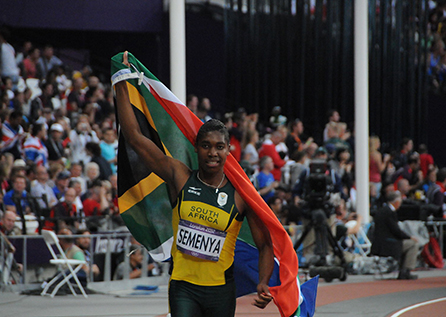Introduction
Fairplay
is defined in the Oxford dictionary as “respect for the rules or equal treatment of all concerned.”
Our team’s goal is to bring light to the different lived experiences of female athletes that are not in the spotlight. Through data journalism practices, the team has come to an understanding that there has been a great amount of progress for women in a male-dominated space. That being said, there are places of opportunity that need a change in order for women to be seen as equal in the sports industry.
Our research and gathered data show the lived experiences, socialization, viewership and limitations that female athletes are still facing today. The more awareness that this project can create, the more likely women will achieve fairplay.
Socialization
LEVELING THE PLAYING FIELD
In the age of social media, everything is about appearance – using filters and effects and pouting your best face forward. Female athletes have felt the heat of unrealistic expectations from society. Athletes still hear that to win or be worthy: be perfect, be beautiful, be feminine. Over the years these unrealistic expectations have translated into stereotypes.
Here is a list of some common stereotypes and some amazing women breaking them.
“You throw like a girl”
“You throw like a girl” – one of the most widely used sports stereotypes. Almost all of us have heard it growing up. Implying that to do something “like a girl” is to do it the wrong way. Such stereotypes help create an assumption that women are less than men. The stereotype acts as a discouragement for girls and helps build a mindset in society that girls aren’t good athletes.
Well, here is Michelle Carter, a shot putter and the current Olympic Women’s Champion throwing like a girl.
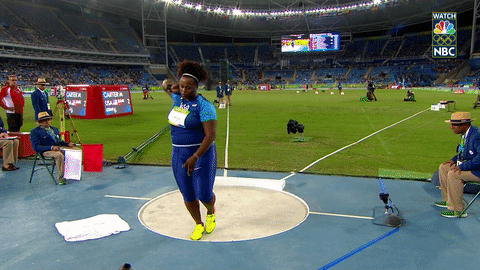
A Man’s Sport
Football, wrestling, boxing, rugby, basketball and the list goes on and on. All these sports are considered a man’s sport. Women are traditionally supposed to be delicate and composed. Therefore, they are often dismissed in violent or contact sports. Young girls are instead asked to join something more girly.
Here’s Ann Wolfe scoring a knock out, one minute into round one against Vonda Ward. Doesn’t look like just a man’s sport.

Muscular But Not Too Muscular
This stereotype also stems from the societal belief that women are delicate and weak or at least weaker than men. Female athletes are expected to be muscular but not too muscular. This is the phrase of choice for people threatened by strong women.
Naomi Wolf in her book, The Beauty Myth explains it as: “A culture fixated on female thinness is not an obsession about female beauty, but an obsession about female obedience. Dieting is the most potent political sedative in women’s history; a quietly mad population is a tractable one.”
From a young age girls are brainwashed into voluntarily physically debilitating themselves. This tips women away from becoming strong, healthy and powerful and leads to eating disorders.
“I think growing up, especially for young girls in judo, it’s really difficult. You’re told the lighter you are, the better you’ll fight,” Kayla Harrison, Olympic Judoka told ESPN. “What I truly believe is that if you’re going to win, you’ll win at whatever weight you fight. I always preach that strong is beautiful, strong is powerful, and you shouldn’t change your body for sport, for society, for anything.”
Pretty Please
Female athletes are expected to look perfect whether on field or off field – not sweaty or tired or out of breath but beautiful, feminine and perfect. To win or to be worthy they must be perfect. Female athletes regardless of their success are more often than not subjected to body policing.
Trying to fit into this image has serious consequences particularly around puberty, when body size, hormones and muscle strength change. According to a report by the National Eating Disorders Association, an estimated 62 percent of female athletes in aesthetic and weight-class sports suffer from eating disorders.
Heather Fisher is an English rugby player. She has severe alopecia, a condition which leads to hair loss. She has struggled with body image issues due to her hair loss that led to anorexia. She says, “Living with an eating disorder is like having someone in your body controlling who you are and how you think about yourself. It’s like you’re in the driving seat of a car and your hands are tied: you know you need help, but you don’t know how to ask for it.”
Motherhood Over Sports
There is an assumption that women quit sports after having kids. This might be true in some cases but there are a number of underlying factors. Unfortunately, athletes do not get paid maternity leaves. If you are not on the pitch, you are not making money. When athletes go on their maternity leaves many brands pull back their endorsements.
For example, Serena Williams was the only woman listed on the Forbes Top 100 Highest Paid Athletes in 2017, but after giving birth and taking maternity leave, she was no longer on the list in 2018. There were no other women listed in the top 100.
Williams won a Grand Slam tournament when she was two months pregnant and was back in the court eight months after giving birth to her daughter. There’s nothing that can stop her.
HOW FEMALE COACHES EMPOWER YOUNG ATHLETES
When Sylvia started coaching, she wasn’t taken seriously.
Most evenings you will find Sylvia standing in the corner of Western University’s purple indoor track. The track circles around a hockey rink which makes the air cooler than you would have expected when you walk into the arena. Sylvia wears a Western branded jacket to keep herself warm as her coaching conditions are a little different than most.
Sylvia is the head throws coach at Western University. She coaches shot put, weight throw, discus, javelin… you name it. Her schedule consists of early morning weight training three times a week on top of the usual throwing technique practices that are held every weekday. On top of practices, Sylvia and her team compete most weekends when the season starts.
Through her career, she has coached junior national medalists, legion national medalists, OUA and CIS medalists and is number eight on the UWO All-Time Top Ten List.
Still, she is not treated equally.
“It remains to this day, a power struggle.” She says over the phone.
As a female throws coach, Sylvia is constantly having to defend herself because of her gender, despite her years of coaching experience. One of her bigger struggles has been to get male athletes in the program as she is only seen to be successful with female athletes.
She tells stories about the numerous times that she has been ignored, belittled and even physically stepped in front of when coaching her male athletes. It is an instinct for the male coaches in this event to confide in other male coaches because throwing is assumed to be a male-dominated space. At a meet full of male coaches, Sylvia stands there, proud and confident giving her athletes instructions.
That being said, she doesn’t let her dismissal among male coaches take away from her throwing team at Western. What makes her team so special at Western is the fact that her team is mostly made of women.
Before every meet, the Western women’s throwing team gets into the middle of the pit and stands in a circle. They all put their arms around each other and hype each other up like a team, regardless of the fact they are competing individually. Sylvia snaps pictures from the sidelines letting her girls lead the way.
One of Sylvia’s athletes Hannah Diebold said that it was always pushed that strong is empowering. In a recent study, ESPN interviewed student-athletes about body image, 30% of female student athletes are still afraid of becoming too muscular.
No one body would have an ideal body for all sports. Every woman’s body in athletics is different and Sylvia made sure that her athletes know that they can be strong and still be feminine.
Not only was Hannah learning to be empowered by her strength but she was learning that you can be empowered by more than one thing. It is always such a fight for these women to be taken seriously in a strength sport as a woman. It can be so easy to be put into a box.
“We are always trying to prove ourselves to be more than just strong but to be athletes in general,” Hannah said.
Sylvia makes it a priority to make a community and a chain reaction for the athletes she is coaching. Every season the team gets introduced to their teammates, coaches, and alumni as family. She said how important it is for these women to see each other as supporters and a community to empower one another.
This chain reaction does not just end with her university athletes. Sylvia encourages the university kids to interact with the kids she is coaching in high school.
“I like my high school kids to see that these women are excelling at sport and school at the next level.” Sylvia said.
It isn’t just about athletic success. It is about seeing a group of women be friends, compete, build confidence and enjoy themselves in sport. It is about not being put in a box. It is about being more than just one thing. More than just a woman. More than just strong. More than just a thrower.
Female leadership may not be the whole answer but it sure is a part of it. Having a coach that understands what female athletes are going through and has a similar lived experience can make all the difference in keeping young girls involved in sport.
“Not every woman is a good coach, but not every man is either.” Sylvia said.
THE SEXUALIZATION OF FEMALE ATHLETES
For female athletes, being talented, determined, and hardworking isn’t always enough.
Whether we choose to admit it or not, ‘the unfortunate importance of beauty’ is alive and well in the sports industry.
At all levels of the game, female athlete’s outward appearances are observed and cast judgment upon in some way or another.
In the case of the world’s top athletes, a price to pay for their success is regular surveillance and feedback from those watching.
Male and female athletes will both experience sexual objectification in their lifetimes. But the sexualization of female athletes uniquely undermines the legitimacy of female athleticism and female sports, unlike their male counterparts.
The sexual objectification of women involves them being viewed primarily as an object of male sexual desire, rather than as a whole person.
The sexualization of female athletes specifically concerns the matter of valuing their attractiveness above all other characteristics, particularly their athleticism.
The sexualization of female athletes has far-reaching impacts.
Young female athletes are socialized in accordance with the understanding that they must maintain beauty while also pursuing their athletic dream, this implicitly shapes their development as an athlete and can alter their level of training.
The sexualization of top athletes can result in greater coverage and admiration for female athletes of higher levels of ‘attractiveness’.
As a result of their eye-catching good looks, society often places these female athletes in higher regard and deems them athletically superior to others of the same calibre.
Most concerning is that this same objectification uses a female’s athleticism against them to further enforce unfair beauty standards.
As a female athlete, the pressure is two-fold. One must be in peak physical condition for their sport while also maintaining society’s perceived conditions for beauty.
This paradox has resulted in some of the top female athletes of our time still being torn down for looking ‘too muscular’.
As if a Golden Slam win was not enough.
Consequently, many female athletes, of all levels, compromise their game to avoid gaining muscle and “looking too manly”.
Women just can’t win, and when they do, they are shamed for not looking right while doing it.
Questioning an athlete’s fitness or preparedness has never been out of bounds, but for female athletes their “preparedness” is often judged through the lens of the sexuality and beauty requirement placed on them by society.
Female Olympians have previously been called fat and too out of shape to compete without acknowledging their accomplished medal-winning record.
Meanwhile, male athletes are given adoring nicknames and catchphrases (“dad bod”) for their less than toned figures, and not once questioned on their ability to compete.
The double standard is all too evident as male athlete’s figures change and no one speculates if they’ve “lost it”.
As Kavitha A. Davidson notes, for male athlete’s their attractiveness does not impede our perception of their athleticism, as it does for women.
Additionally, a male athlete’s attractiveness has an incredibly lesser impact on their financial gains as an athlete, than a female’s does.
Since classic models of earning through athleticism and talent do not exist for women as they do for men, top female athletes must often wager their beauty and sex appeal in hopes of garnering higher marketing potential.
Competing in sports should not revolve around someone’s appearance, it should focus on their unique talent and determination.
But this will not change until our socialization does.
One way of instilling these ideals into our society is through the visual representation of our top athletes.
The ESPN Body Issue is a special annual feature meant to celebrate the power of the athletic form.
For ten years now, the world’s top athletes have graced the cover in all their nudity in hopes of representing the many shapes and sizes that a powerful athlete can be.
However, the unique sexualization of women is rampant throughout.
The most notable difference between the male and female photoshoots is the emphasis on strength, power, and the male’s sport, versus beauty, smiles, and nakedness for the female athlete’s photos.
In 2010, Julia Mancuso posed for the ESPN body issue.
Julia Mancuso is an accomplished alpine ski racer and Olympic gold medalist.
Below is her cover shot compared with another talented skier and Olympic medalist, albeit he is male.
Here we have two athletes competing in the same sport, both reigning Olympic champions, but we’re being told two entirely different stories.
Julia Mancuso’s photo hardly even informs the viewer what sport she plays, considering they posed her in a hayfield rather than the snow of all things.
Another stark comparison was depicted in the 2009 ESPN body issue seen below. The emphasis on a smiling attractive female compared to a strong athletic man is explicitly clear.
Both these athletes are American professional soccer players. Natasha Kai is also an Olympic gold medalist. Neither of these athletes looks less athletic or stronger than the other here.
However, posing and placement is everything when telling a visual story. The details matter.
Yet, again, we have the female athlete without any indication of what sport she even plays.
Oguchi Onyewu is posed with a soccer ball and a powerful stance on the block amidst a serious expression. While Natasha, no doubt looking amazing, has no reference to her sport or athletic prowess.
Over the last ten years, there have been some improvements as is evident in the two cover shoots below of female surfers.
At first glance, these photos may appear similar in style, but what is markedly different between them is an absence of what is known as the male gaze in their imagery.
The “gaze” is a term that describes how viewers engage with visual media.
The male gaze suggests a sexualized way of looking that empowers men and objectifies women.
In the male gaze, the woman is visually positioned as an “object” of heterosexual male desire. Her feelings, thoughts and her own sexual drives are less important than her being “framed” by male desire.
The male gaze is apparent in Claire Bevilacqua’s photoshoot from 2009, where greater emphasis is placed on her nakedness than her athleticism. In Lakey Peterson’s 2019 photoshoot, the nakedness is still there but the focus has changed.
Both these women are top athletes and equally impressive, that is why their visual representation matters.
The ESPN issue in its right is progressive, as it shows bodies of all kinds and challenges what we expect out of a professional athlete’s physique.
But there is still a long way to go in the ‘equal objectification’, if you will, of men and women amongst their annual issues.
Double standards for the objectification of men and women show up in uniform rules as well, specifically the highly watched sport of beach volleyball.
Since 1996 when beach volleyball was introduced to the Olympic games, the sport has grabbed the attention of many television viewers.
Back then, viewers could expect to see women diving over the sand wearing matching bikinis.
The uniform options included only a bikini or a bodysuit, most women chose the former since the bodysuits are specifically designed for colder weather.
All the while, men were playing the exact same sport in shorts and tank tops.
Ironically, most male beach volleyball players play shirtless by choice, yet at the Olympic games, they are required to cover up, unlike their female counterparts.
This raised the question of whether women were being exploited for their bodies specifically during televised competitions.
Not all players or countries have had an issue with the bikini requirement, but for a long time, the beach volleyball uniform had been excluding players due to religious or cultural sensitivity reasons behind not being able to wear the uniform.
In 2012 however, the uniform requirements received a much-needed update. New options finally granted women slightly more coverage and welcomed new competitors to the game.
As of 2020, the options still remain relatively limited.
Women may opt for a T-shirt style cropped-top paired with 3cm above the knee-length shorts, or a sleeveless tankini style top and shorter shorts sitting 26cm above the knee.
For those with stricter personal allowances, they are still only permitted to wear the cold weather full piece bodysuit.
There are some critical distinctions to be made within the guidelines…
Men are permitted tanks with “open arms”, while women are permitted tanks with “deep cutaway armholes on their back, upper chest, and stomach”.
It is hard to rationalize a technical or physical reason why women need a more gapingly open uniform for the same sport.
Additionally, in the opening page for Tokyo 2020’s uniform guidelines under “Concept”, The Fédération Internationale de Volleyball states,
“Beach Volleyball athletes compete in a beach and open-air environment and are required to project a healthy image to the audience, media, partners, etc.”
It is curious as to why the first sentence of a uniform guideline book immediately acknowledges the importance of the viewers above anything else.
Most importantly above the technical, practical, or performance-enhancing aspects to a uniform.
The components that impact the game, not our view.
Yet again, prioritizing the physical appearance of players over their athleticism.
WOMEN IN SPORTS FILMS
How many films or television shows can you name that centre around sports, or characters whose motivations lie in their dedication to their sport? It feels like every CW protagonist is concerned with the balance between their social life and their place on the school’s team. We have shows and films like Friday Night Lights, which centre on the way a high school football team impacts its smalltown home. We see Troy Bolton from High School Musical sing about having “his head in the game, but heart in the song.” We watch as Coach Carter influences his team to reform their lives through sport.
But how many films or television programs show girls in the same circumstances? Do we ever see women’s sports teams existing as entities that unite their schools, or their hometowns? Do we see women’s teams get the same kind of support or recognition that men’s teams do?
When we see women playing sports in media, it’s for one of two reasons: she’s confronting gendered expectations in her chosen sport (think A League of Their Own, She’s The Man, or Million Dollar Baby) or she’s playing a sport that’s traditionally associated with women and femininity (Bring It On, Ice Princess), with very little in between.
Women just aren’t offered the same opportunities in real life or on-screen. If a girl in a film is into sports, it tends to become her whole personality. There is no room for her to wrestle with herself about artistic ambitions vs her desire to play sports. If there’s conflict about her personal life vs her sport life, it will usually centre on how she can maintain her relationships, either romantic or familial.
It feels like women have to choose between what she wants to be and what she wants to do. Much like in real life, the conflict rests in whether the female character in question can “have it all.” Can she be invested in her hobbies, have a good relationship with her family and enjoy the companionship of a significant other? Can she balance everything she hopes to achieve?
In contrast, if men’s sports films have a conflict that centres around their families, it’s usually about the destructive nature of their chosen sport, and how they’re putting themselves in danger to participate. For women, it’s not about whether the sport will harm them, it’s whether the women can play the sport at all, and if she can, how it makes her “unladylike.” Usually, this woman has to deal with an unsupportive family. While there’s something empowering in making it happen yourself, despite naysayers, it still reflects the realities of how women are forced to choose one thing or the other.
The stories about female athletes become stories about the men in their lives. In Million Dollar Baby, working-class Maggie’s triumph in the ring ends midway through the film after she is paralyzed. This makes way for a drama that centres on her male trainer’s moral dilemma about whether he should honour her wishes and help her die. She goes from fighting against the expectations of her gender, to a daughter-surrogate that helps her trainer reconcile with his real daughter. She ends the film as a device.
That story is a tragedy.
It’s not wrong to like these films, to find Million Dollar Baby moving or to find Rocky inspirational. We just must highlight the discrepancies between the two movies and their working-class heroes.
When men lose, they can still find a way to win. When women lose, they lose.
Fiction mimics reality and reality mimics fiction; that’s the way it has always been. Fictional men get to win against the system, win championships, be the heroes; women are lucky to just be in the system at all, and are heroines because they beat gendered expectations.
When gender is at play, even in fiction, nothing is fair.
WHERE WOMEN IN SPORTS AND WOMEN IN VIDEO GAMES MEET
Women are often underrepresented in video games, regardless of gender. While that has begun changing in recent years, it is still not the norm to see playable female characters at the centre of big-budget games. Games are considered a male-dominated industry, both in terms of the consumer base and in terms of development teams. While the question of whether men actually dominate the industry is up in the air, it is nevertheless true that women are underrepresented.
This goes doubly so for representation as playable characters in sports games.
By “sports games,” we are not talking about things like Mario Tennis, where you can play as a variety of Super Mario characters. We’re talking about the big, tentpole, annual releases of games like Madden, FIFA and NBA Live, where female players are relatively unheard of; in the case of Madden, it makes sense; there is no female equivalent to the NFL. But in the case of NBA Live games and FIFA, there are female teams that are included, to better represent female players in the leagues and perhaps attract female gamers to the games in the first place.
FIFA added female characters to their roster beginning with FIFA 16, released in 2015. In 2017, the game added a fictional female character in the story mode of FIFA 2018, allowing players to experience a new side to the sports world. The change was refreshing; representing women in a non-cutesy sports game, as the serious athletes they are, was a step in the right direction.
Of course, that didn’t mean there wasn’t criticism. The FIFA 16 female player reveal trailer on YouTube has a split between people who thought EA’s introduction of female players was long overdue, and those who thought that it was unneeded. Criticism took on a sexist angle, asking why EA had “wasted” resources to include female teams. That no one wanted to play as a female character or play as female teams when they could play as men, that the game was bending to appease feminists, that adding women to the game was outlandish and would be followed by animals.
One commenter specifically asked that the game add “empty stadiums” at the female teams’ games to capture reality.
All this, in response to the concept that female athletes deserve to be represented, too.
While gaming is traditionally seen as a masculine hobby, studies and data show that almost half of the gaming audience is female. With FIFA‘s popularity with hardcore and casual gamers alike (FIFA 2018 was able to sell 24 million copies worldwide), it stands to reason that a large percentage of FIFA fans are, in fact, female.
And why wouldn’t they be? FIFA is geared to be accessible for a broad audience, and many play it with their friends as a way to socialize. While some take it seriously and go pro (in e-sports), many just want to play online with their friends.
NBA Live‘s addition of the WNBA also helps people form a bond with the league and its players. When NBA Live unveiled their WNBA trailer, the comments were all over the place. In almost an exact recreation of the reaction to FIFA, one commenter said, “now the WNBA’s one fan can truly be happy” as a way to dismiss the genuinely progressive move to include the WNBA.
But, again, there were people in the comments cheering the decision on. Another commenter said the decision was the right business choice, as it pushed rival developer 2K to step up their game, so to speak. They also mentioned that it’s better to innovate and give the audience something new, rather than just the same thing every year with little variation.
And, like in FIFA, players aren’t required to go through the female league games, or do a career mode campaign with a female character. But it’s there for the people who do want to see female athletes represented, and it’s there for the people who are just curious about the leagues they aren’t familiar with.
Creating a more welcoming environment for female players (both of the game and of the actual sport) encourages people to understand the world of female athletes. It creates a familiarity, with the team, with the position, with the players that can’t even be reproduced by just watching the game. It’s the kind of thing that can only be done when the experience is inherently immersive, and requires the active participation and thought of the audience member.
When people say you have to “walk in someone else’s shoes” to understand where they’re coming from, they don’t mean it so literally.
But maybe games like FIFA can begin bridging the gap between female and male athletes and create a more inclusive, welcoming environment to both female athletes and female fans.
STRENGTH ISN’T JUST AN ADVERTISING BUZZWORD
Think about ads.
Think about sports ads.
Then think about sports ads aimed at women.
“Strong is beautiful,” says WTV.
“Now confidence comes in all sizes,” says Nike about a sports bra. (Despite the thin, conventional beauty of the model)
All these things are well and good; women have been an oppressed class for a very long time, and seeing ads that tell them to break the psychological cages that beauty standards enforce on them feels a lot like empowerment.
But is it?
What does it say when the women in these ads tend to be conventionally attractive, thin and overtly feminine? When ads tell women that beauty isn’t important when they’re strong and capable, but places beautiful women as the subjects of those ads? The world wants to tell women that conventional attractiveness is a trait of a less progressive society, but they just end up enforcing the status quo.
We want to believe that everyone is beautiful, and everyone is in their own way, but we place qualifiers on what beauty means. It’s not kindness or thoughtfulness, or generally being a good person, it’s just another type of body. A new ideal that women have to achieve to feel like they’re worth attention. These ads want to tell women that their bodies don’t matter as long as they’re strong, while also enforcing the idea that there is an ideal body type, ignoring those who don’t fit into that mould.
Of course, athletic women deal with a lot of scrutiny when it comes to their bodies. If they’re visibly muscular, they may feel like they’ve been stripped of their femininity because they too don’t fit a specific mould. It’s a tricky tightrope to walk, and while advertisers are trying to be more inclusive by showing these “unconventional” body types, there is still a coded message: that bodies must be a certain way to be accepted, and if they’re not then those ads aren’t for you.
And even then, physically fit bodies are not met with the same kind of criticism or scorn as plus-sized bodies. There’s a bit of a mind trick going on to convince people that strong, fit bodies weren’t always considered an ideal to be aspired to. Since advertising began, women have been told that they should aim to be physically fit.
There’s also the question of ableism in these ads: some people just cannot do the things that these ads celebrate, and are rarely represented in media at all, let alone media that would celebrate their bodies. Does that make them less worthy of the label of “beautiful”? A lack of physical strength?
And then, there’s the issue of how strength is defined.
Why is it just about bodies? Why doesn’t it include the kind of strength you can’t see? If a person struggles with depression and has a lot of trouble functioning on a day to day level yet does so anyway, isn’t that an example of strength? Where are the ads for people who exist in a world that does not make it easy for them?
Why do we have to define strength (and, therefore, beauty) as physical? It can be so much more than that.
And why do we let ads create the definitions for us?
These ads have an insidious effect on the way women perceive themselves. Now, women have to not only be beautiful; they have to have the physical strength of an athlete to feel like their bodies are good ones; to feel like their bodies are beautiful ones.
If advertisers still use the concept of beauty or attractiveness as their focus for their ads, especially of sports goods, then they are just reinforcing a norm, regardless of how progressive the ads are trying to be.
Women should be athletic because they want to be, because they enjoy it, not because advertisers are co-opting the language of body-positive feminism to push more products.
Women shouldn’t be afraid to be physically strong, but likewise, they shouldn’t be scared to be physically weak, either. Regardless of what ads say, strength shouldn’t just be measured in terms of physical feats.
There is so much more to aspire to than just physical fitness. And while these ads do celebrate determination, drive and positive attitudes, its goal is to do two specific things: sell a product, and sell an image.
And maybe it’s time that image changed.
Lived Experience
A WOMEN’S RUN
A Women’s Run is a run club based in Toronto, Canada founded by Fatma Ramadan and inspired by Nike Run Club. It was created in May 2019 with the help of Deena and ML, the executive and creative directors respectively.
The club encourages and empowers women of colour not only by helping them train and ‘putting in a workout for the day’ but by also making them feel confident and claiming spots and spaces outside of the club for them. A Women’s Run aims to constantly elevate the females’ stories by organizing photo shoots and posting many team photos on their Instagram page to recognize the women’s performances and efforts.
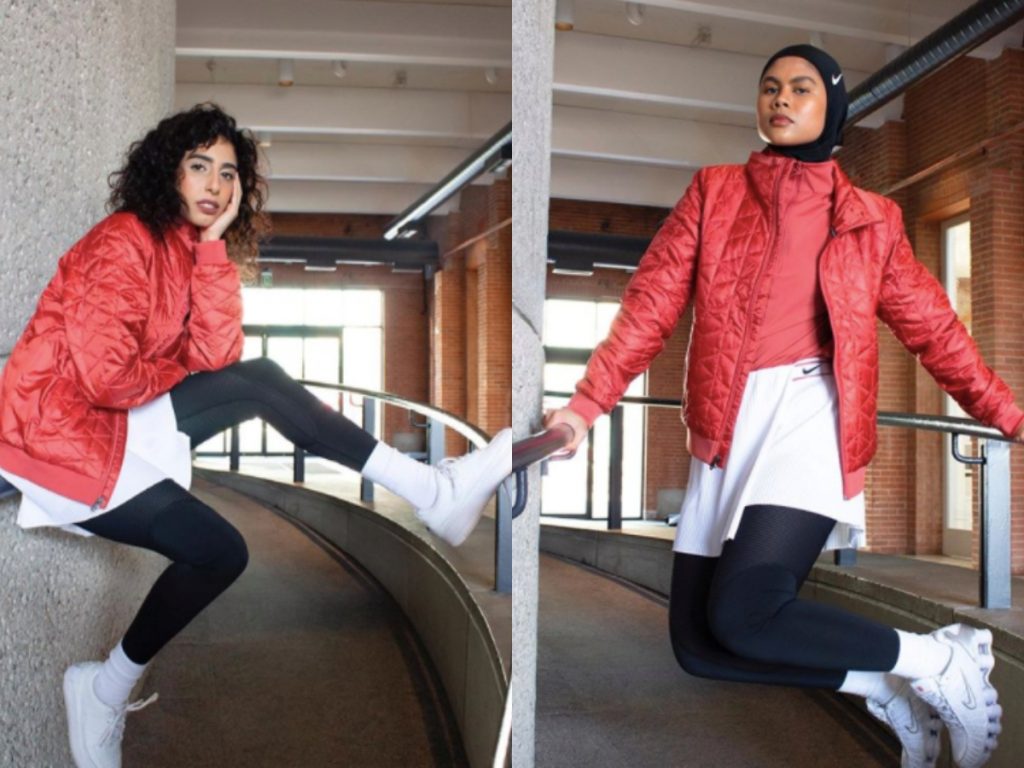
The first campaign launched in the summer of 2019, targeted women of colour and brought in more women to represent them through the campaigns. The campaign also helped them train for the Scotiabank’s Half Marathon. But the club has quickly transformed into a safe community space for women of colour to showcase their sports interest and not feel intimidated by others.
A sense of community and family is also seen through women’s participation in running during the coronavirus pandemic. The A Women’s Run Instagram page has reposted a lot of the trainees’ pictures of their running trails within their own neighbourhoods, showing how they have been staying fit while staying home. They continue to recognize females’ dedication and confidence during these difficult times. They have also allowed some of the trainees to take over A Women’s Run’s Instagram page to document a day in their life during this self-isolation period, from what they are eating to how they fit in a workout at home.
Like Ramadan said, a lot of the girls have reached out to other fitness events and communities and have attended themselves, occupying these spaces and representing women of colour. Not only do they participate in sports but they also are taken seriously in sports.
Ramadan hopes the run club gets bigger, and more women of colour take on Toronto’s trails while in the process feeling confident, not only within sports but outside of it.
“You still matter, you are an athlete!” – Ramadan
HIJAB AND SPORTS
Most of the time when little girls reach a certain age in the Middle East, their families would enforce certain cultural traditions on them. Sometimes those are based on religion. A Hijab and burka are two of the many means parents use to enforce “Islamic identity” on their young girls. Athletic clothing sometimes contradicts the Islamic perception of modest clothing.
It’s to the extent that you can clearly see that sportswomen in many Arab countries are fighting issues much simpler than the wage gap. They just want to be included.
Salam and Heba were born in the city of Daraa in south Syria, a conservative city. People will often judge a woman walking in the street without a hijab and label her as indecent and immodest. Both girls are now residing in Milton, Ontario and they still carry that perspective with them.
“We never played any sport because we never got a chance to. It’s very normal for a girl not to be included in any activity outside the house in our family,” Salam said.
In the predominantly sunny south of Syria, many families see sports as something for men. Salam and Heba say they were always told that a good girl prepares the meals for her brothers and then cleans the dishes after. Heba said her parents would give her money every time she wore her hijab when she was eight. The girls have always wanted to play Quill, but their parents always told them they could not afford it.
“They would give me few dollars every time I wore the hijab until I finally wore it, but they would say 15 dollars a month for Quill lessons is way more than they can afford,” Heba said.
The two sisters are now looking to enrol in colleges in Ontario. They say they are used to not be included in the sports world.
“We can’t play sports now because we think it’s too late, people start when they are young, we are 21 and 26 years old, we can play it for fun but not on a professional level,” Salam said.
They do believe the next generations of girls in the Arab world could be different especially since the Arab Spring. Salam did participate in protests against the Assad regime in her school in south Daraa.
“After the Arab Spring people became braver to say and do what they want, imagine that at some point people wouldn’t even dare to discuss politics in public and now they can curse Assad in public. If this can happen then we can do whatever we want,” Salam says.
They say the new generations of girls can and should be more independent; however, they believe it still will be hard.
“Despite almost nine years of war, many families still control the choices of their girls whether it’s what they wear, how they speak, how loud they speak, who they speak to and when they would go out, what to study and where they will always either take those decisions for them or at least manipulate them emotionally to choose what they want them to choose,” Salam said.
They believe that spreading awareness about the issue and letting girls know that it is their future and their choice and no one else’s, is the key to the solution.
“We should make girls know that in the end, no one knows what they want better than themselves,” Heba said.
In other parts of the Middle East, things could be better or worse. Rawan Hedefa from Egypt spent her childhood in Saudi Arabia. Hedefa says her community was very supportive of girls playing sports, it’s just that you cannot play freely in Saudi Arabia.
“In order to swim well, appropriate attire is needed to be worn. Thus, it was difficult to actively participate in this sport,” Hedefa says.
When asked about her experience in Canada, Hedefa said the lack of access to free sports facilities, the bad weather, and excessive schoolwork are the main reasons she does not do sports in Canada.
TRANSGENDER WOMEN AND SPORTS
The laws that regulate trans women’s participation in global sports event like the Olympics are, to a great extent, built around testosterone levels. On October 2003 a committee convened by the International Olympics Committee (IOC) to set new guidelines for transgender people participating in the Olympics. The committee that had professors from France, Sweden, and the United states. The committee established three conditions for transgender people welling to participate in the world’s largest sport event. First, they have to undergo sex reassessment surgery that includes genital changes and a gonadectomy. Second, they must have legal recognition of their asserted sex by the appropriate authorities. Third, athletes must have undergone treatment for an appropriate amount of time. The committee later decided an appropriate time must be at least two years.
In October 2019, the laws were changed; the testosterone limit for transgender competitors was reset to 5 nmol/L, from the previous 10 nmol/L. The new change further restricts the participation of transgender woman by reducing the limit of “appropriate” testosterone levels.
In Canada there are separate laws regulating the participation of transgender people in sports.
In secondary education, for example, some provinces have independent laws regarding transgender people. Organizations like Alberta School Association, Manitoba High School Athletics, and BC school Sports have policies that allow transgender people to participate in sports events with their gender identity.
The governing body of Canada’s post-secondary education athletics U-Sports introduced a new policy in 2018 regarding transgender students’ athletics. The new policy allows transgender students to compete according to their gender identity.
Despite the fact that Canadian associations have lenient laws regarding those who identify as transgender and their participation in sports, they still need to abide by international laws when participating in international events.
Like the case of athlete Caster Semenya, international laws are still using testosterone as the tool that decides an athlete’s gender. Semenya lost an appeal against the new rules introduced by track and field’s world governing body (IAAF). The ruling allowed testosterone to determine her gender identity and disqualified her from participating in track and field competitions. Another case is that of Canadian cyclist Kristen Worley. Worley transitioned from a male into a female in 2004. Twelve years later she took both the World Anti-Doping Agency and the International Olympic Committee, to the Ontario Human Rights Tribunal. The court ruled that the process Worley went through to get back to competition violated her human rights.
UCI Masters Track World Champion Veronica Ivy, formerly known as Rachel McKinnon, has received an estimated 100,000 hate messages on Twitter after winning the title according to a report by BBC sports. The BBC report cited British government figures which suggest that there are between 200,000 to 500,000 transgender people in the UK, equating to 0.3%-0.75% of the population.
In 2017, Australian women’s handball team player Hannah Mouncey was banned from being nominated for the women’s Australian Rules draft. The reason was the size difference between her and her opponents. Mouncey told The Guardian in an interview in 2018 that her biggest concern is how size is being used as measure for possible exclusion.
“If you’re too big, you can’t play. That is incredibly dangerous and backward”, Mouncey said in her interview with the guardian.
In an interview with CBC news, Canadian researcher and IOC adviser Joanna Harper talked about her personal experience of her transition and the effects of testosterone blockers and estrogen on her performance. Harper told CBC that within months of hormone therapy, her pace slowed down 12 %. She added that while women have testosterone levels of less than three nanomoles per liter, men’s levels can reach 30 nanomoles per liter. A Thomson Reuters Foundation poll, 1000 women were asked the question: “Should transgender women have the same rights as other women?” The poll showed that 80% believed transgender women should have same rights as other women.
The variation between women and men’s levels of testosterone and its effect on performance gives the hormone enough credibility to be the judge in the case of transgender people. The problem that remains is finding a middle ground that guarantees fair competition and inclusion at the same time. The current laws are working only in favour of fair competition and ignoring inclusion.
Until today, the laws regulating transgender people participation in sports are using testosterone as the judge deciding an athlete’s identity and that judge often mistakes athlete’s testosterone levels to testosterone doping.
VIEWERSHIP
Historically, women’s games have attracted less audience than men’s games. Women’s games also have fewer sponsors and advertisers compared to men’s games. According to a report by Tucker Center for Research on Girls & Women in Sport, women make up 40% of all sports participants, yet women’s sports receive only 4% of all sports media coverage.
Similar trends of disparity can be traced back closer to home. We looked at Ontario University Athletics (OUA) and Ontario Colleges Athletic Association’s (OCAA) game schedules for volleyball, basketball, and soccer from the last season.
(function(d){var js, id=”pikto-embed-js”, ref=d.getElementsByTagName(“script”)[0];if (d.getElementById(id)) { return;}js=d.createElement(“script”); js.id=id; js.async=true;js.src=”https://create.piktochart.com/assets/embedding/embed.js”;ref.parentNode.insertBefore(js, ref);}(document));For more than 95% of OUA and OCAA games, men played at prime time. In this context, prime time is when the viewership or turnout is higher. As seen in the above graphs, all three sports have men’s games scheduled in the evening, either at 3 pm or at 8 pm. These games were played right after the women’s games, which were at 12 pm or 6 pm.
The timings are not very far apart, so one would think that women’s games would have the same audience. But that’s not the case. Women’s games often appear to act as a build-up event for men’s games.
“This difference can exist as the men’s games often play at later times where people can attend more and I feel some people find the guys more entertaining,” a volleyball Sheridan college athlete, Tamia says.
She thinks better marketing might help.
“[It’s about] promoting, showing exciting clips of women’s games and that it is just as fun and entertaining to be at,” she said.
“Women work just as hard and should get the same treatment when it comes to sports.”
“Historically, men’s games have had higher attendance and viewership numbers on OUA.tv,” says Director of Marketing and Partnerships David Frizzell.
“Our members have expressed an interest in scheduling more women’s games at preferred times but it is up to each individual school to make that decision,” he says.
Female players don’t get as much attention from the mainstream media as male players.
In her article for The Atlantic, Maggie Mertens said “the thinking goes that if women’s sports were worthy of more coverage, they would receive it.”
In the article, Perdue Professor Cheryl Cooky points out that a lot of our perceptions of how interesting women’s sports are come from the media itself.
“They have higher production values, higher-quality coverage, and higher-quality commentary … When you watch women’s sports, and there are fewer camera angles, fewer cuts to shot, fewer instant replays, yeah, it’s going to seem to be a slower game, [and] it’s going to seem to be less exciting,” Cooky said.
As women around the world fight for equal rights, representation of female athletes in the media should be at par with their male counterparts. The world of sports is no longer a man’s world and the media should be more mindful of not treating it like one.
Limitations
TEAM CANADA RIO 2016
Despite the very welcoming nature of Canada and the huge support it provides to its newcomers and refugees, many girls believe the lack of access to sports facilities for low-income families is another reason to avoid sports. However, they still hope for action to be taken by the municipal and federal government to encourage low-income families and newcomers to participate more in sports activities. After analyzing the 2016 Rio Olympics, we found that team Canada was comprised of 290 female participants. But none of the female participants were from Arab or Middle Eastern backgrounds. None were Hijab wearing athletes, and less than 10 percent of female participants were women of colour. These findings begged the question: did these women not have access to sports? Were they just not talented enough? Or were they some how too intimidated to try?
What if women are given a chance?
For women who are able to compete, they are bringing success to Canada’s Olympic team. Just by sheer numbers Team Canada’s women are creating an undeniable impact on Canadian sports legacy. Who knows what heights of influence this legacy could reach if it showcased more of the the diversity that the country prides itself on.
BELOW: “YOUR TEAM CANADA BY THE NUMBERS INFOGRAPH” BY PAOLO PAGCANLUNGAN
Women belong in sports, and they prove it over and over. The Olympic Charter states: “To encourage and support the promotion of women in sport at all levels and in all structures with a view to implementing the principle of equality of men and women.” If that doesn’t sound like it carries enough weight, that’s okay. Women can speak for themselves.
And it’s not just with words.
The ongoing journey to equality in sports moves forward with women pushing the envelope with excellence and fair play. They have been doing this since the beginning, and that is why the success of current athletes is evermore visible.
BELOW: “Gender Representation in Every Olympic Game Ever” BY PAOLO PAGCANLUNGAN
It’s no secret. Girls don’t just want to have fun. They want to win.
They do. And they will.
AN AMPLIFIED LOSS FOR FEMALE STUDENT-ATHLETES
Thousands of elite female student-athletes graduate every year, leaving their sport behind forever.
Anyone who is an athlete or has been an athlete understands the amount of effort you put into a sport you love. You take on the identity of the athlete. If you continue to do sports through post-secondary, it becomes almost impossible to picture a life without having practice every day, seeing your teammates every day, or having a specific goal to work towards.
The feeling that athletes are losing their identity makes the transition from school to the workforce much harder than it needs to be.
Laura Vere is a past collegiate basketball player and now assistant coach for Laurier Women’s basketball Team. She’s currently living the dream, but that wasn’t always the case.
Vere was a point guard and captain of the basketball team at Fanshawe College. Before her four years at Fanshawe, she was a high-level hockey player as well as a high-level basketball player. She was always an athlete, whether it was basketball or hockey. It was an identity.
“Who are you? You’re an athlete. That is who you are.” Vere says, reminiscing over the phone.
Vere knew that it couldn’t last forever. It was bound to end at some point. When her student-athlete identity was slipping away, she was trying to figure out how to replace it. If she wanted to continue basketball professionally, she would have had to uproot her whole life and move to a different country. There are no leagues for female basketball players here in Canada. That being said, there are two leagues for men. The Canadian Elite Basketball League and National Basketball League of Canada.
Even if Vere wanted to move away to continue her basketball dreams, it wouldn’t be as simple as a tryout. She would have to find an agent to fight for a position overseas because there is way less of an audience for women’s basketball.. How long can someone put off their life to chase a glass ceiling?
“If you aren’t going to Europe and you aren’t getting drafted into the WNBA, how are you keeping basketball in your life?” She said.
The answer is that many women don’t. It’s not because they aren’t talented enough or because they don’t have enough experience; it’s because there are limitations on women’s opportunities in sport.
Before she was offered her job as a coach, she didn’t know who she was trying to become. She had to find something new to place all the energy she was used to spending on her sport, but the question was where?
“You don’t have the practice to go to, you don’t have your 12 best friends with you every night,” Vere said. “I [would] feel so alone because I [didn’t] have that here anymore.”
Natasha Wesch, a mental performance consultant and counsellor, works with athletes and says it is a challenging transition for many athletes.
“They feel that there has been a part of them that has died or been lost.” Wesch explained.
Wesch believes that there are three things you can do to help the transition. The first is to plan. Many athletes wouldn’t think to plan for the loss of their career like they would plan for a loss of a person. Sometimes having a plan beforehand is what can keep you from being so thrown off when it happens.
The second is to do an inventory of what your athletic skills are and how to transfer them into the next chapter of your life. So many athletes learn life skills at an incredibly fast pace during their years in sport that will help them once they transition to the working world. The key is to see that all those years of work and effort can continue to help you in the future.
Lastly, the final tip would be to stay involved or connected with the community. This can be through refereeing, coaching, or getting a job in the sports industry.
However, a report released by University of Toronto called the Gender Equality Report states that only 17 percent of university head coaches in Canada are women.
The limitations on opportunities in the sports world creates a mental battle for women who have to leave that life behind. The sooner equality is reached in the sports industry, the easier it will be for these female athletes to continue to keep their passion for sports alive. Some people don’t have to fully leave that identity behind.
Luckily for Vere, this was the case. She was able to mould her identity as an athlete to being a coach.
“I get to translate my love for basketball to someone else and help them find their love of basketball,” Vere said. “There is no way I can live or function without basketball.”
“Playing like a girl means you’re a badass.”
Former U.S president Barak Obama
When president Obama said those words, he was honoring the U.S Women soccer team in the White House after winning the world Cup in 2015. But still the best soccer team in the world is not treated as equals to their way less glamorous men’s soccer team.
The United States Soccer Federation claims it’s highly concerned about revenues, and that the women’s team is not generating as much as the men’s team. But is this true?
*The numbers don’t lie.
To start, the USWNT’s home jersey scored record sales according to Nike chief executive Mark Parker. He said, according to Business Insider, that the jersey “is now the number one soccer jersey, men’s or women’s, ever sold on Nike.com in one season.”
According to a report from The Washington Post in 2019, the women’s team contributed close or more than half of the federation’s revenue from games since fiscal year 2016. In fiscal years between 2016 to 2018, the women’s games generated about $900,000 more revenue than the men’s. In the year that followed the women’s team win of the 2015 World Cup, women’s games again generated more money than men with a total of $1.9 million.
The report adds that, in fiscal 2015 and 2016 combined, the men’s team had a revenue of about $3 million. The women’s team revenue was $8 million in 2016 alone.
*Systematic bias
What is FIFA’s role in the making of the wage gap?
Total prize money for the Women’s World Cup in 2019 was $30 million — the U.S women Soccer team walked away with about $4 million. For men, however, the French national team won $38 million in the 2018 Men’s World Cup in Russia.
That means the champions of the men’s world cup won more money than the total prize of the entire women’s tournament.
The Washington Post report says this means the U.S men’s soccer team earns more money for losing a game in the World Cup qualifiers than the women earn for winning one.
THE “HOLE” PICTURE
It all adds up.
It’s no surprise that athletes bear the brunt of the spotlight when any issue is highlighted in the world of sports. These issues, however, are no stranger to all of the other women that make it possible for athletes to compete at their highest level. The problems of misrepresentation and lack of compensation for women are rooted deep into the business of sports, too.
They seep into the salaries of sports management, especially in the marketing department.
BELOW: “GENDER PAY GAP IN SPORTS MANAGEMENT” VISUAL BY PAOLO PAGCANLUNGAN
They have made their way into the training staff and the culture of organizations that are responsible for the development of these professions.
BELOW: “NUMBER OF CURRENT FEMALE COACHES IN PRO AMERICAN SPORTS” BY PAOLO PAGCANLUNGAN
This makes perfect sense.
People know who they know, and if logic prevails, will hire accordingly. There is a cultural shift happening in the athletic training industry, but it is slow in moving because decision makers fall to what choices their experience and environment will allow them.
The roots dig even further.
Coaching staffs, which are often put in the hot seat of attention beside the players, are also riddled with male dominance. It shows at the highest levels of competition that, even though some sports are touted for pioneering progressive change in diversity of staff recruitment, facts remain.
BELOW: “GENDER DISTRIBUTION OF THE NATIONAL ATHLETIC TRAINERS’ ASSOCIATION” VISUAL BY PAOLO PAGCANLUNGAN
The disparity between male and female is made even clearer at the ownership level. Within sports team owners alone, the combined net worth of America’s female team owners (and co-owners) would not add up to the richest male team owner. There are nine women, in total, who own sports teams (if you count a few being the mother of team certain financial heirs) in America.
BELOW: “FORBES’ TOP 20 RICHEST SPORTS OWNERS” VISUAL BY PAOLO PAGCANLUNGAN
At the highest level of sports ownership, women have merely scratched the surface. Even the addition of the net worths of Martha Firestone Bird (Detroit Lions), Virginia Halas McCaskey (Chicago Bears), Gail Miller (Utah Jazz), Jeanie Buss (LA Lakers), Joan Tisch (New York Giants), Denise York (San Fransisco 49ers), Amy Adams Strunk and Susie Adams Smith (Tennessee Titans) would not equate to the top of the list.
This tells an even bigger story of disparity between men and women outside of the sports realm.
Upon further investigation, the gender disparity picture gets bigger. And so does the hole inside it.
Progress
WOMEN TO WATCH
In spite of the barriers that women in the sports industry face, they still succeed. Women are fighting to make names for themselves in a world where some believe they should not be. Here are a list of phenomenal women who are changing the sports industry for the best because of their success, drive and passion for sports.
Serena Williams – Tennis Player
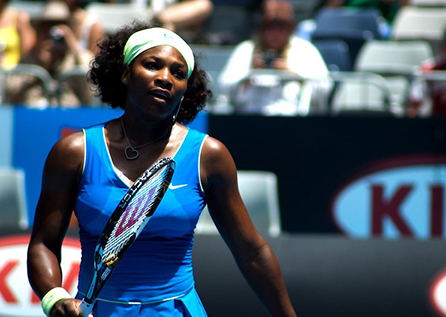
Serena Williams is an American professional tennis player, having started playing at age five while growing up in Compton, California. She has won 23 Grand Slam singles titles which, in the Open Era, is more than any woman or man has ever achieved. Overall, Williams has won 39 Grand Slam titles in the singles, doubles and mixed doubles categories. She became the second black woman to ever win a Grand Slam title at the U.S Open in 1999. She was ranked No.1 eight times by the Women’s Tennis Association over the course of her career. She is a UNICEF Goodwill Ambassador and opened two Serena Williams Secondary Schools in 2008 and 2010.
Caster Semenya – Middle Distance Runner
Caster Semenya is a middle-distance runner from South Africa. She won gold at the 2012 and 2016 Olympic Games, and at the 2009, 2011 and 2017 World Championships for the 800 metre women’s categories. In 2016 she won the 400m, 800m and 1500m titles at the South African National Championships, all within the same day. She was the first athlete to win all three of these titles.
The International Association of Athletics Federation (IAAF) announced new “differences of sex development” rules in 2018 which, when rolled out, would require female athletes in the 400m, 800m and 1500m categories with sex development disorders to alter their testosterone levels to participate. Caster has been legally challenging this decision ever since.
Megan Rapinoe – Soccer Player
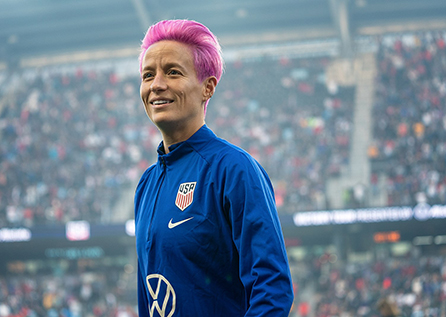
Megan Rapinoe, an American footballer and self-described “walking protest” is well-known for her unique, inventive style of play as a forward and midfielder, and her LGTBQ and gender equality advocacy. Along with the U.S. National team, Rapinoe won gold at the 2012 Olympics; the 2015 FIFA Women’s World Cup; and the 2019 FIFA Women’s World Cup. She was the part-time captain and leader of the American team during the FIFA Women’s World Cup win in 2019, and openly stated she would never visit the Whitehouse despite a personal invitation from President Trump in protest of his Administration’s policies.
Rapione has been the driving force of the team’s lawsuit against U.S. Soccer for gender pay-equity discrimination. She was named the best FIFA Women’s Player and Sports Illustrated Sportsperson of the Year in 2019. She is the first openly gay athlete to ever appear in the magazine.
Laurel Hubbard – Weightlifter
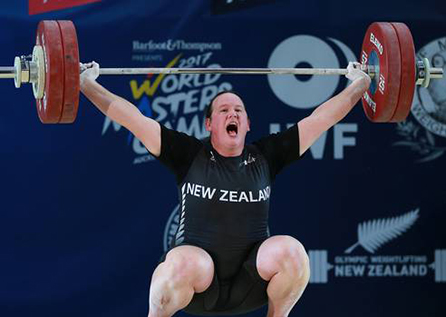
Laurel Hubbard is an Olympic weightlifter. She is also a transgender woman. She won two gold medals and a silver medal at the Pacific Games in Samoa in 2019 in three heavyweight categories. Before her transition she competed in men’s weightlifting. In 2017, New Zealand Weightlifting approved Hubbard to compete internationally in the 90kg+ female category – which was considered a spearheading move for the LGTBQ sports community. When she won gold in this category at the Australian International and Australian Open in Melbourne, she became the first transgender woman to obtain an international weightlifting title.
Ishita Malaviya – Surfer

Ishita Malaviya is the first female professional surfer in India. She has been featured on the Forbes 30 under 30 list, and in several documentaries and films about surfing. In Karnataka, she runs the Shaka Surf Club and Camp Namaloha, which teaches people in the community how to surf and have a deeper respect for the sport. Malaviya was involved in the first Summer Swell Challenge in Pondicherry and is the first Indian Brand Ambassador for Roxy surf wear.
Nada Askar Al Naqbi – Executive Supporting Women in Sport
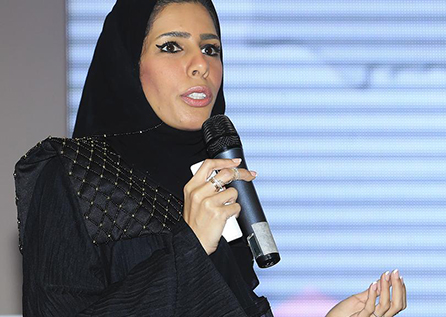
Nada Askar Al Naqbi is the Head of the Executive Committee and Director General of Sharjah Women’s Sports (SWS) HE and the Deputy Head of the Supreme Organizing Committee at the Arab Women Sports Tournament (AWST). The most recent Arab Women’s Sports Tournament in Sharjah had a record number of women attending and exemplified the increasing significance of sports in women’s lives in the UAE. For over 15 years Al Naqbi has been committed to helping women take part in professional competition and has had leading roles in facilitating pan-Arab women’s sporting events, including the Asian Games and GCC Women’s Games. She has been outspoken about elevating women’s sports and she strives to empower more Arab women to participate in sports by creating more opportunities for them.
Chantal Petitclerc – Wheelchair Racing Athlete
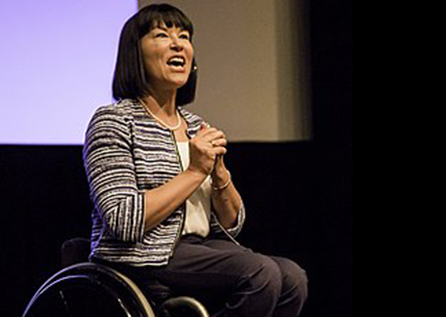
Chantal Petitclerc is known internationally as a Canadian wheelchair racing athlete from Quebec, as one of the most successful Paralympic athletes of all time, and as a fierce advocate for inclusivity. She has won 27 medals at the Olympic games, Paralympic Games and Commonwealth Games and was appointed as the Chef de Mission for Team Canada at the Rio Paralympic Games in 2016. Petitclerc is a spokesperson for Defi sportif AlterGo, which she has been doing for 17 years, and is an ambassador for Right to Play. She is an athlete mentor and also an avid public speaker.
Aries Susanti – Climber
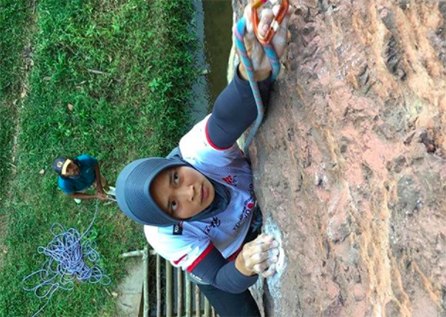
Aries Susanti, nicknamed “Spider Woman,” is an Indonesian speed climber. She set a world record for women’s speed climbing in 2019 at the IFSC Climbing World Cup in China, having climbed a 49-foot wall in 6.99 seconds. During this climb she became the first woman to climb that distance in under 7 seconds. As a speed climber athlete, she is ranked third globally. In 2019, she appeared in Forbes Asia’s “30 Under 30” list. In 2020, the Olympics will host sport climbing for the first time, which Susanti says she hopes to compete in.
Simone Biles – Gymnast
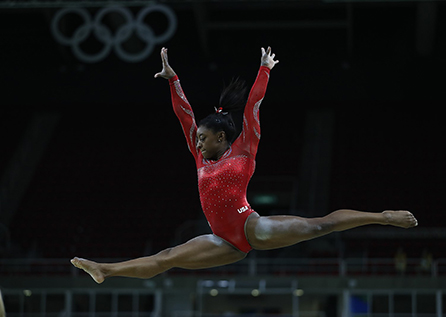
Simone Biles is the most decorated artistic gymnast in the world, in both men’s and women’s categories. She is a four-time Olympic champion and has won 19 gold World Championship medals (with a total of 25 medals won at the World Championships, and 30 medals overall). She won five titles at the World Championships in Stuggart, Germany in 2019 and she was named the 2019 Female Athlete of the Year for Team USA. Biles was the first woman to win five all-around, three balance beam and five floor exercise world titles.
Jen Welter – NFL Coach
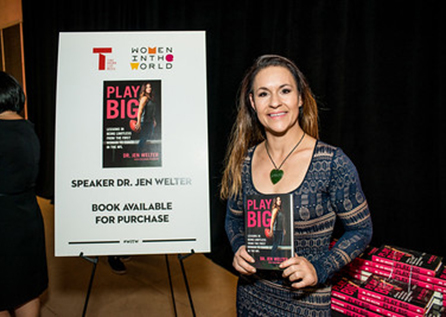
Dr. Jen Welter is the first woman to coach in the National Football League (NFL), first hired by the Arizona Cardinals in 2015 as the linebackers’ coach. Prior to that in 2014, Welter was the first female to play in a men’s professional indoor football league as a running back, and the second woman to play in a position other than kicker or holder in that league. At the time she was considered as one of the world’s top female tackle football players. In 2015, Welter was asked to be a linebacker and special teams’ coach for the Texas Revolution indoor football team, being the first woman to coach in t he INFL league. Welter has also won two gold medals at the International Federation of American Football’s (IFAF) Women’s World Championship with Team USA.
Bianca Andreescu – Tennis Player
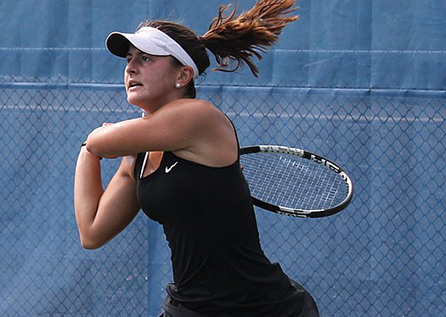
Bianca Andreescu is a professional tennis player. She is a Canadian of Romanian origin, having started playing tennis at age seven. Her singles career high ranking is fourth in the world (as of October 2019) and is the highest ranked Canadian in Women’s Tennis Association history. She won three titles at the 2019 U.S. Open championship and her victory against Serena Williams in New York had a record audience of 3.4 million viewers. It was the most watched tennis broadcast ever on TSN.
Alyssa Nakken – MLB coach
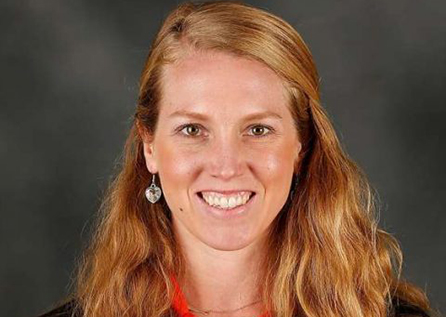
Alyssa Nakken became the first ever full-time Major League Baseball (MLB) coach in early 2020 for the San Francisco Giants, and is currently an Assistant Coach. Prior to this, Nakken was an all-conference first baseman three times for Sacramento State and later became a baseball operations intern for the San Francisco Giants in 2014. She proceeded to work her way up in the operations and business departments and as a coach now focuses on clubhouse culture and structure.
Diana Taurasi – Basketball Player
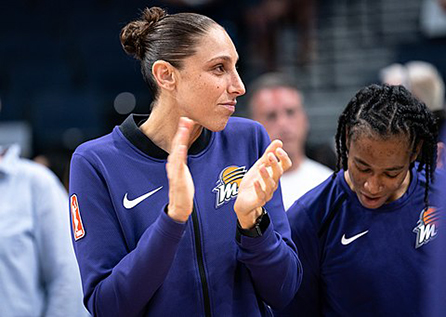
Diana Taurasi is a basketball player in the Women’s National Basketball League (WNBA), playing for the Pheonix Mercury team. She has won four gold medals in the Olympics, three WNBA championships, five scoring titles in the WNBA and three FIBA World Cups. Taurasi is currently the WNBA all-time leading scorer going into 2020 and was named as one of the greatest players in WNBA history in 2016. She is one of five athletes in the world to win four gold medals in basketball in the Olympics and one of 11 athletes to win all of the following: A World Championship gold medal, an Olympic gold medal, an NCAA title and a WNBA championship.
Vicki Keith Munro – Marathon Swimmer
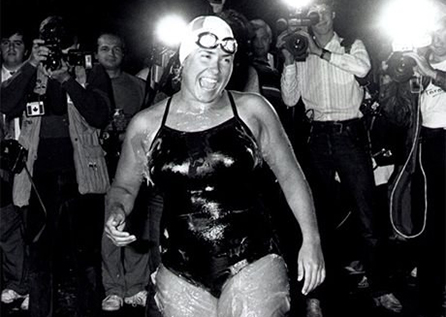
Vicki Keith Munro is a retired Canadian marathon swimmer currently making waves for youth athletes with physical disabilities, having raised over one million dollars for their athletic opportunities to date. She set 16 world records in her time as a marathon swimmer and was the first and only person to do a double crossing of Lake Ontario. In 1988 she was the first person to cross all five of the Great Lakes. Keith Munro founded the Penguins Can Fly aquatics program in 2001, which later became the largest Canadian Para swim team.
Shireen Ahmed – Sports Activist

Shireen Ahmed is an award-winning sports activist and industry expert on Muslim women in sport and racism and misogyny in sport. She is an Inclusion and Diversity Consultant, an athlete, a writer and a public speaker. Currently, she contributes to Muslimah Media Watch, is a sports coach and mentor, and is involved in empowerment projects with the organization Youth of Colour. Ahmed is one of five women who created the first feminist sports podcast called Burn It All Down.
Lao Khang – Rugby Player and Coach
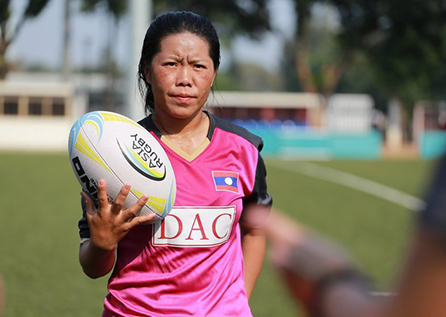
Lao Khang grew up in a small village in the Nonghet district of Laos and was the first Hmong woman to receive a rugby coach license. As a rugby player, she has been referred to as a major part of Laos Women’s National Rugby team’s unprecedented international victories as rugby team captain. Khang is a strong believer in the life-changing influence of sport in the lives of children in developing communities. She works as the Development Officer with the Laos Rugby Federation and manages over 40 coaches for teams across the province of Xieng Khouang. Before this, she facilitated rugby activities for youth in her village with Childfund Alliance Laos. Khang was named on the BBC 100 Women list in 2018 and Forbes’ 30 under 30 – Asia list in 2019 for her achievements.
Jayna Hefford – Ice Hockey Player
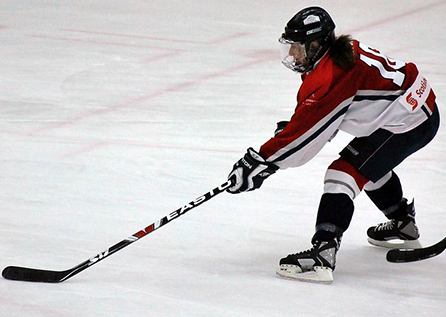
Jayna Hefford is known for her participation in professional ice hockey and is known as one of the longest standing members of the National Women’s Team in Canada. She is one of the Canada’s most decorated Olympians with five Olympic medals (four of them gold). She also won seven gold medals and five silver medals at the World Championships. Hefford retired in September 2015 and is affiliated with several charities including Right to Play and CanFund.
Dina Asher-Smith
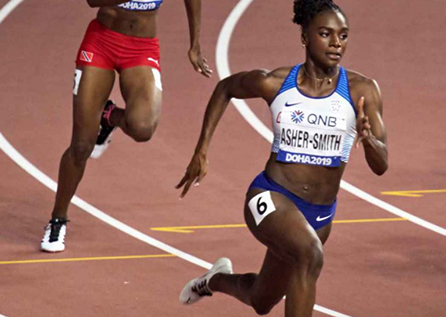
Dina Asher-Smith is a professional British sprinter. She is known as Britain’s fastest woman, having smashed records in the British 100m, 200m, and 4x100m sprinting categories. But those weren’t the first world records she has achieved. When Asher-Smith was as young as 13 years old, she broke the world record for best time in the 300m category. At 17 years of age in 2013, she was the youngest athlete at the IAAF World T&F Championships in Moscow representing the British team and the youngest athlete to ever win a medal (bronze) for a World Championship relay. Asher-Smith is also the first British woman to have won a world title in 100m and 200m categories.
Conclusion
The challenges women face aren’t just confined to sports. Living life as a woman can feel limiting, like a cage of expectations dictated by society. Women aren’t socialized to consider what they can be, but what they can’t be. Don’t be ugly, don’t be too pushy, don’t be too loud or weigh too much or be too muscular or not be muscular enough.
Don’t. Don’t. Don’t.
It’s time for a change – a structural reset.
This website, our website, has aimed to shed some light on the injustices faced by women in sports. Through careful examination, interviews, and data research, we have uncovered the realities and challenges that women in sports face on an alarmingly regular basis.
Pay inequity. Beauty standards. Representation. Accessibility.
All of these issues affect women on a broad scale, but especially those in traditionally male-dominated fields like sports. Women feel unwelcome in athletics, fearing social judgement or the loss of social standing because of their “masculine” interests. They feel like they will never be equal to men, especially when it comes to physical activities. From childhood, women are taught that “like a girl” is just another way of saying inferior.
But it is not.
From the famous athletes like Serena Williams to the women behind the scenes like Coach Sylvia Kontra to the newcomers like Bianca Andreescu to the women who want to make a difference in their community like Fatma Ramadan. This website is proof of their dedication and hard work, their tenacity, and their unshakeable spirit. It is a reminder that all women deserve to feel welcome; that women can disregard the discouraging messages society sends. Messages that make these extraordinary athletes feel unworthy, or that tell them “muscular girls aren’t hot” or “don’t, that’s for boys” – those messages have no place in the future that we’re building together.
But this isn’t a sprint. It’s a marathon. And sexism, especially in a male-dominated field, doesn’t just end because some articles are written about it. It ends when people are informed of how social norms can be harmful; it ends when people begin to instigate change for the better. It’s a slow process, one that requires a steady pace and the motivation to do what must be done to reach that end goal of equality.
This isn’t the end.
We’re just getting started.




